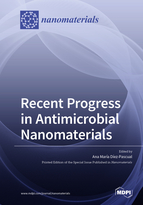Recent Progress in Antimicrobial Nanomaterials
A special issue of Nanomaterials (ISSN 2079-4991). This special issue belongs to the section "Biology and Medicines".
Deadline for manuscript submissions: closed (10 August 2020) | Viewed by 59653
Special Issue Editor
Interests: nanomaterials; polymers; nanocomposites; inorganic nanoparticles; antibacterial agents; surfactants; interphases
Special Issues, Collections and Topics in MDPI journals
Special Issue Information
Dear Colleagues,
Bacterial infections are a well-known and serious problem in numerous areas of everyday life, causing death and pain and huge added costs to healthcare worldwide. They also cause major issues in many other industries, such as textiles, water treatment, marine transport, medicine and food packaging. Despite the strong efforts by academic researchers and industry, a universal solution for controlling bacterial adhesion and proliferation has not yet been found. Over the last years, many novel antibacterial nanomaterials have been developed, and some of them are already applied in hospitals and public buildings. This Special Issue aims to bring together the latest advances in the field of antibacterial nanomaterials and their applications in various fields. Selected contributions on recent advances in the synthesis, characterization, and applications of nanomaterials with antibacterial activity are welcomed.
Potential topics include, but are not limited to:
- Antimicrobial nanoparticles
- Antibacterial nanocoatings and nanocomposites
- Antimicrobial mechanisms
- Antimicrobial food packaging
- Adverse effects of nanomaterials
- Future perspectives for antimicrobial nanomaterials
- Role of antimicrobial nanomaterials in medicine
Prof. Dr. Ana María Díez-Pascual
Guest Editor
Manuscript Submission Information
Manuscripts should be submitted online at www.mdpi.com by registering and logging in to this website. Once you are registered, click here to go to the submission form. Manuscripts can be submitted until the deadline. All submissions that pass pre-check are peer-reviewed. Accepted papers will be published continuously in the journal (as soon as accepted) and will be listed together on the special issue website. Research articles, review articles as well as short communications are invited. For planned papers, a title and short abstract (about 100 words) can be sent to the Editorial Office for announcement on this website.
Submitted manuscripts should not have been published previously, nor be under consideration for publication elsewhere (except conference proceedings papers). All manuscripts are thoroughly refereed through a single-blind peer-review process. A guide for authors and other relevant information for submission of manuscripts is available on the Instructions for Authors page. Nanomaterials is an international peer-reviewed open access semimonthly journal published by MDPI.
Please visit the Instructions for Authors page before submitting a manuscript. The Article Processing Charge (APC) for publication in this open access journal is 2900 CHF (Swiss Francs). Submitted papers should be well formatted and use good English. Authors may use MDPI's English editing service prior to publication or during author revisions.
Keywords
- antibacterial activity
- nanocomposites
- bacterial infection
- nanotoxicology
- antibiotic resistance







